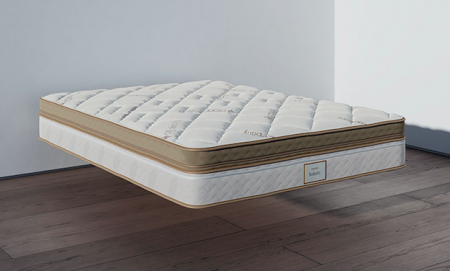The Solaire by Saatva combines the innovative, adjustable design of classic airbeds with the pressure-relieving comfort of other mattress types.
The mattress features one (twin XL and full sizes) or two air chambers (all other sizes) in the support core. Owners can adjust the firmness of the bed by adding or releasing air. The Solaire offers a firmness range of soft (3) to firm (7), which accommodates the vast majority of sleepers regardless of their weight and sleep position.
The Solaire is also constructed with an organic-cotton pillow-top, which offers exceptional padding, along with comfort layers of gel-infused memory foam and zoned Talalay latex. These materials cradle and support the sleeper’s body, and can alleviate aches and pains as they develop.
In addition to standard sizes, the Solaire is available in Upper Flex Queen and King sizes, which are split from the top to the midsection; this allows owners to elevate the head of their bed using an adjustable base. Split King and Split California King sizes are also available. These options make the Solaire very suitable for couples with differing comfort preferences.
All Solaire orders in the contiguous U.S. and Canada qualify for free White Glove delivery, which includes in-home assembly and old mattress removal; most competing brands charge $100 to $300 for this service. The Solaire is also backed by a 365-night sleep trial and a lifetime warranty.
The Bottom Line.
The Solaire by Saatva checks all the boxes for what an airbed should offer, and then some. The bed is available in a variety of sizes, including split sizes, so individuals and couples with a range of comfort and firmness preferences can all enjoy a good night’s sleep on the same bed. Moreover, Saatva includes premium perks like free White Glove Delivery and backs the mattress with an extensive sleep trial.

